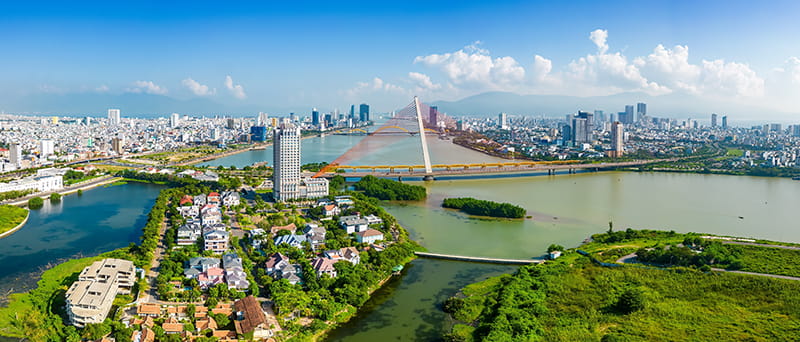Read the latest thoughts and analysis on breakthrough solutions driving impact for a sustainable future
The New Boomtowns: Where Climate Resilience Is Shaping the Cities of Tomorrow

Today, the most dynamic urban frontiers are not defined by wealth or size alone, but by another force: resilience. A new class of cities is emerging, places that are adapting to climate risks but also using those adaptations to reimagine their future.
Some are rediscovering their value after years of stagnation. Others are forging ahead through bold experimentation. All over the world, as these cities are reshaped by migration, investment, and urban planning, they are discovering that climate resilience can be a catalyst for reinvention.
Urban planning for holistic sustainability
Some cities demonstrate a profound, systems-thinking approach to climate adaptation, integrating resilience into every aspect of their long-term urban planning.
The green corridors of Medellín exemplify this. Just a few decades ago, the Colombian city was better known for cartel conflict than climate action.
Today, it offers an inspiring story of urban transformation in the face of climate change. Once nicknamed the "City of Eternal Spring" thanks to its temperate climate, by the 1980s, rising temperatures coupled with rapid development and the destruction of green spaces had led to a city plagued by heat and pollution.
Launched in 2016, Medellín's 30 green corridors have stitched together streams, roadways, parks, and even vertical gardens with millions of plants and trees. The effect has been remarkable, with an average temperature decrease of 2°C across the city. This green revolution had the side effect of helping reclaim a fractured civic identity, becoming a prime example of how building climate resilience can profoundly impact social wellbeing and identity.
Curitiba, Brazil, has long been a darling of sustainable urbanists. For 60 years, the city has been integrating climate adaptation into every aspect of design. Permeable pavements reduce flash flood risk, linear parks help manage stormwater, and energy-efficient buildings and public transport continue to drive down emissions. It's a city that treats every climate investment as a chance to improve daily life.

Curitiba, Brazil
Across the world, Singapore has reimagined itself as a “City in a Garden.” Green roofs crown public housing, stormwater flows through manmade wetlands, and urban trees offer cooling shade in the tropical heat. To prepare for future threats, the wealthy island nation has drawn up a comprehensive climate action plan, and infrastructure investment is done with a resilient future in mind.
From vulnerability to prosperity
For other innovative cities, climate adaptation and resilience are a chance to transform vulnerabilities into economic and social opportunities.
Surrounded by the Sahel, Ouagadougou, the capital city of Burkina Faso, is dealing with encroaching desertification, deadly heatwaves, and increasing urban heat. Recognizing these threats, the city is revitalizing a 2,000-hectare green belt of trees, vegetable plots, and water tanks. The project, which has its roots in the 1970s, rings the city – forming a cooling barrier that also supports livelihoods and helps feed a growing population. It’s an example of turning climate challenges into opportunities for economic development and food security.

Da Nang, Vietnam
In Southeast Asia, the coastal harbor city of Da Nang, in Vietnam, is buffeted by typhoons that lead to severe flooding. Because of this, the city is one of the region’s most proactive when it comes to climate adaptation and disaster resilience. It is investing heavily in early warning systems, flood-resilient housing, urban greening, and energy efficiency. This has brought economic benefits as well as building up knowledge and human capital, transforming its vulnerability into a foundation for growth.
Meanwhile, the city of Pune, in India, has attracted an influx of people, many of whom are farmers migrating from neighboring drought-prone regions. The city is leveraging its status as a technology hub to become a tech-enabled smart city with green infrastructure. Among its initiatives are investments in circular approaches to waste management, sustainable transportation, and tree-planting projects, demonstrating how proactive adaptation can drive prosperity.
A resilient and sustainable future
The World Bank predicts that climate change will force 216 million people to migrate within their countries by 2050. Climate adaptation, along with mitigation efforts to reduce environmental impacts and avoid the worst projections, is a necessary and pragmatic act in the arc of human history. One that will help us evolve to live in reconfigured cities that are more sustainable for the coming future.
A new narrative is emerging, one that views resilience not just as a line of defense but as a foundation for prosperity.
More Articles
22 DECEMBER 2025
Smart Cities
Three case studies on AI’s growing role in urban planning and mobility
19 DECEMBER 2025
Decarbonization
5 Ways Supply-Chain Circularity Is Making Countries More Climate-Resilient
18 DECEMBER 2025
Sustainability


